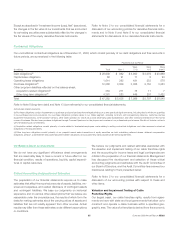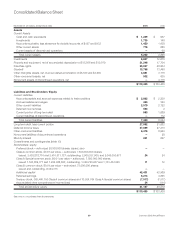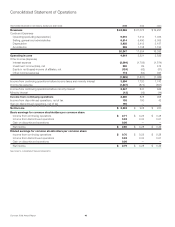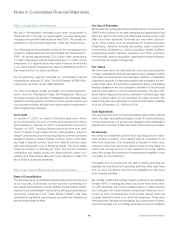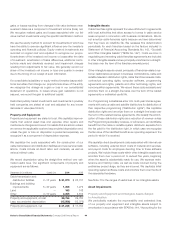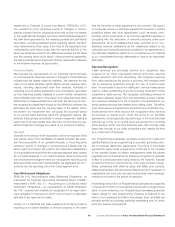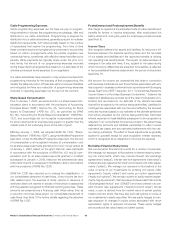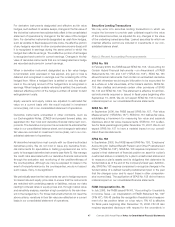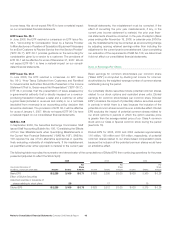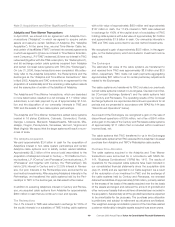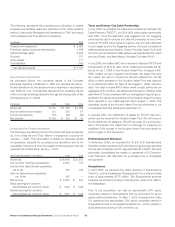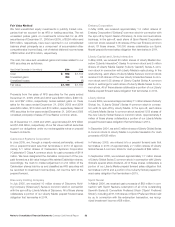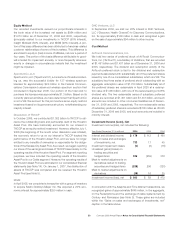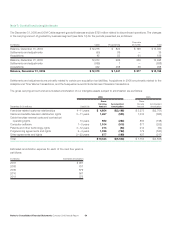Comcast 2006 Annual Report Download - page 47
Download and view the complete annual report
Please find page 47 of the 2006 Comcast annual report below. You can navigate through the pages in the report by either clicking on the pages listed below, or by using the keyword search tool below to find specific information within the annual report. 45 Comcast 2006 Annual Report Notes to Consolidated Financial Statements
Impairment or Disposal of Long-Lived Assets” (“SFAS No. 144”).
Our evaluations occur whenever events or changes in circum-
stances indicate that the carrying amount may not be recoverable
or the useful life has changed, and they include analyses based on
the cash flows generated by the underlying assets and profitability
information, including estimated future operating results, trends or
other determinants of fair value. If the total of the expected future
undiscounted cash flows is less than the carrying amount of the
asset, we recognize a loss for the difference between the fair value
and the carrying value of the asset. Unless presented separately,
the loss is included as a component of either depreciation expense
or amortization expense, as appropriate.
Franchise Rights
We evaluate the recoverability of our franchise rights annually,
or more frequently whenever events or changes in circumstances
indicate that the assets might be impaired. We estimate the fair
value of our cable franchise rights utilizing various valuation tech-
niques, including discounted cash flow analysis, multiples of
operating income before depreciation and amortization generated
by the underlying assets, analyses of current market transactions
and profitability information. If the value of our cable franchise rights
determined by these evaluations is less than the carrying amount,
we recognize an impairment charge for the difference between the
estimated fair value and the carrying value of the assets. When
we perform our impairment test, we group the recorded values
of our various cable franchise rights into geographic regions. We
evaluate these groups periodically to ensure impairment testing is
performed at an appropriate level. We have not recorded any sig-
nificant impairment charges as a result of our impairment testing.
Goodwill
Goodwill is the excess of the acquisition cost of an acquired entity
over the fair value of the identifiable net assets acquired. We evalu-
ate the recoverability of our goodwill annually, or more frequently
whenever events or changes in circumstances indicate that the
asset might be impaired. We perform the impairment assessment
of our goodwill one level below the business segment level, except
for our Cable business. In our Cable business, since components
one level below the segment level are not separate reporting units
and have similar economic characteristics, we aggregate the com-
ponents into one reporting unit at the Cable segment level.
Asset Retirement Obligations
SFAS No. 143, “Accounting for Asset Retirement Obligations,” as
interpreted by Financial Accounting Standards Board (“FASB”)
Interpretation (“FIN”) No. 47, “Accounting for Conditional Asset
Retirement Obligations — an Interpretation of FASB Statement
No. 143,” requires that a liability be recognized for an asset retire-
ment obligation in the period in which it is incurred if a reasonable
estimate of fair value can be made.
Certain of our franchise and lease agreements contain provisions
requiring us to restore facilities or remove property in the event
that the franchise or lease agreement is not renewed. We expect
to continually renew our franchise agreements; however, a remote
possibility exists that such agreements could terminate unex-
pectedly, which could result in us incurring significant expense in
complying with the restoration or removal provisions under such
agreements. No such liabilities have been recorded in our con-
solidated financial statements as the obligations related to the
restoration and removal provisions contained in our agreements or
any disposal obligations related to our properties are not material
to our consolidated financial statements or cannot be reasonably
estimated.
Revenue Recognition
Cable revenues are principally derived from subscriber fees
received for our video, high-speed Internet and phone services
(“cable services”) and from advertising. We recognize revenues
from cable services as the service is provided. We manage credit
risk by screening applicants through the use of credit bureau
data. If a subscriber’s account is delinquent, various measures are
used to collect outstanding amounts, including termination of the
subscriber’s cable service. We recognize advertising revenue at
estimated realizable values when the advertising is aired. Installa-
tion revenues obtained from the connection of subscribers to our
cable systems are less than related direct selling costs. Therefore,
such revenues are recognized as connections are completed. Rev-
enues earned from other sources are recognized when services
are provided or events occur. Under the terms of our franchise
agreements, we are generally required to pay to the local franchise
authority up to 5% of our gross revenues earned from providing
cable services within the local franchise area. We normally pass
these fees through to our cable subscribers and classify the fees
as a component of revenues.
Our Programming businesses recognize revenue from cable and
satellite distributors as programming is provided, generally pursu-
ant to multiyear distribution agreements. From time to time these
agreements expire while programming continues to be provided
to the operator based on interim arrangements while the parties
negotiate new contractual terms. Revenue recognition is generally
limited to current payments being made by the operator, typically
pursuant to the prior contract terms, until a new contract is nego-
tiated, sometimes with effective dates that affect prior periods.
Differences between actual amounts determined upon resolution of
negotiations and amounts recorded during these interim arrange-
ments are recorded in the period of resolution.
Advertising revenue for our Programming businesses is recognized
in the period in which commercial announcements or programs are
aired. In some instances, our Programming businesses guarantee
viewer ratings for their programming. Revenue is deferred to the
extent of an estimated shortfall in the ratings. Such shortfalls are
primarily settled by providing additional advertising time, at which
point the revenue is recognized.


